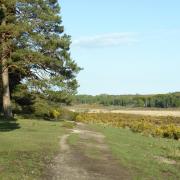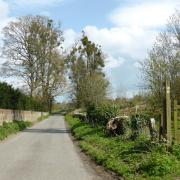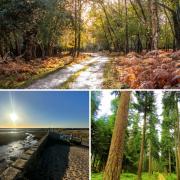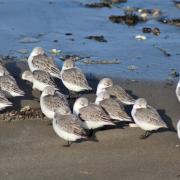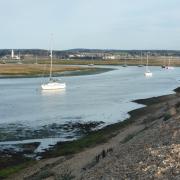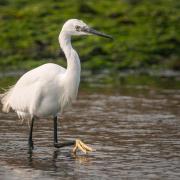Hayling Island lies between Langstone Harbour to the west and Chichester Harbour to the east, with a road bridge at its northern end connecting it to the mainland at Langstone. There’s also a pedestrian ferry across the mouth of Langstone Harbour linking the western tip of the Island with Eastney, Portsmouth on Portsea Island. Before construction of the original wooden toll bridge in 1824, the only access to and from the Island was by boat or across the wadeway, a low-tide causeway route for pedestrians and horse riders. The route is still marked as a bridleway on the OS map today and is discernible at low tide. However, it should certainly not be attempted since it is impassable having been cut in two by a deep channel for the construction of the Portsmouth-Arundel Canal.

In 1865 a railway bridge was built for the Havant to Hayling branch line.1000 feet long, it was an impressive piece of Victorian engineering that could be opened in the centre to allow vessels to pass between the two harbours. Known as the Hayling Billy line, it was very popular with visitors in the summer, but by the 1960s the bridge was in poor condition. The estimated cost of £400,000 (1963 prices) for the work required, resulted in the line’s closure in 1963 and the subsequent demolition of the bridge. Today, all that can be seen of it are the remains of the timber legs, which were encased in concrete for reinforcement.

The track bed has now been converted into a popular trail, open to walkers, cyclists and horse riders. The Hayling Billy Trail - or Coastal Path, as it is also known - runs from Havant to the south of Hayling Island, following the original route of the railway, except for the former bridge crossing. Instead, it now crosses the modern Langstone Bridge which opened in 1956.
At the north-west end of Hayling Island, just off the Hayling Billy Coastal Path, the former oyster beds are now a nature reserve, serving as a haven for overwintering birds and an important seabird breeding site. Walkers can follow a path that loops round past the reserve rejoining the main route further on. Oysters were farmed on Hayling during the 19th and 20th centuries.

This easy out-and-back walk starts from the car park next to the Ship Inn at Langstone. There’s a bus stop here, too, with frequent services from Havant, where there is a train station. Nearby is the Royal Oak and just beyond it Langstone Mill, unusual for having both a windmill and a watermill. After the mills stopped working they were converted into a house, today privately owned and a local landmark. Worth a short detour either at the beginning or end of the walk (simply follow the Solent Way along the coast from the Ship Inn).
The walk
1. (SU719047) From the car park the walk turns left to cross Langstone Bridge. There are pavements on both sides, but bear in mind you will need to turn off the right-hand (west) side once across the bridge, so either cross the road as soon as it is safe to do so or use the central reservation on the far side of the bridge, just before the petrol station. Opposite it, follow the surfaced track which bears right away from the road to a car park. Stop and enjoy the views of Langstone Harbour at the information panels, where you can also read about the birds to be seen.

2. (SU719039) Just before the track swings left back to the road, turn right along the signed Hayling Billy Coastal Path. When the track turns left, detour right past the wooden barriers and restored signal to view the remains of the railway bridge, then continue south along the trail.

3. (SU717037) At the next junction, turn right up the steps to follow the path signed for the oyster beds. Information panels tell you more about their history and role today as a nature reserve. Bear right at the next junction to continue beside the water to a car park where the Hayling Billy Trail is rejoined. This was formerly North Hayling Halt, a request stop on the line.

4. (SU717029) Continue along the track – initially there’s an embankment path beside it which provides better views over the water. You’ll pass a pillbox (see information panel) and then a signed Shipwright’s Way sculpture. (The Shipwright’s Way is a 50 mile long-distance route that runs from Alice Holt Forest to Portsmouth, making use of the Hayling Billy Trail for its penultimate section. There are sculptures placed at intervals along the route.) At a junction, keep straight on, signed for Station Road, West Town. The last section of the track runs inland from the coast, the trail ending at the road/T-junction in West Town. To visit the beach, keep ahead along Staunton Avenue opposite.
5. (SU709997) Turn round and follow the Hayling Billy Coastal Path back to the start.

Compass Points
Start/finish: Public car park next to Ship Inn, Langstone (SU719047)
Map: OS Explorer OL8
Distance: 7¾ miles (12.5km). Walk can easily be shortened by turning round sooner or taking the bus back from Hayling Island at the end of the trail.
Terrain: Very easy walking entirely on the flat on surfaced trail, with excellent bird watching. No stiles.
Time: 3 hours
Refreshments: Ship Inn (02392 471719) and Royal Oak (02392 483125), Langstone; refreshment van at North Hayling Halt car park.
Public transport: Stagecoach buses 30 & 31 from Havant to Hayling Island via the Ship Inn, Langstone. Trains to Havant.




